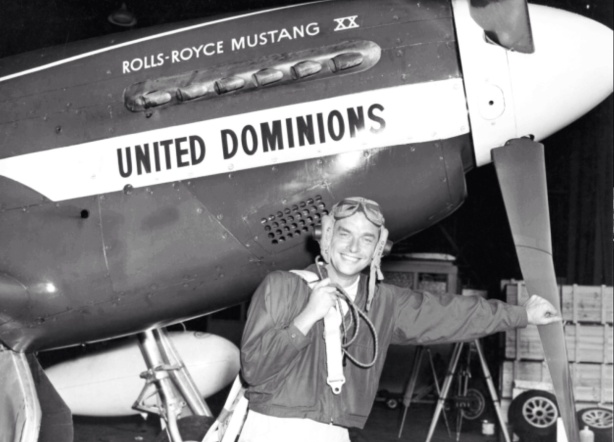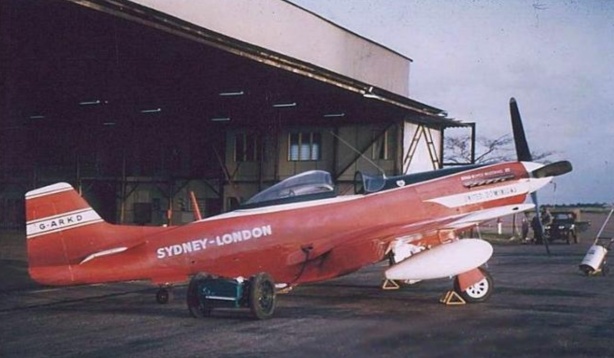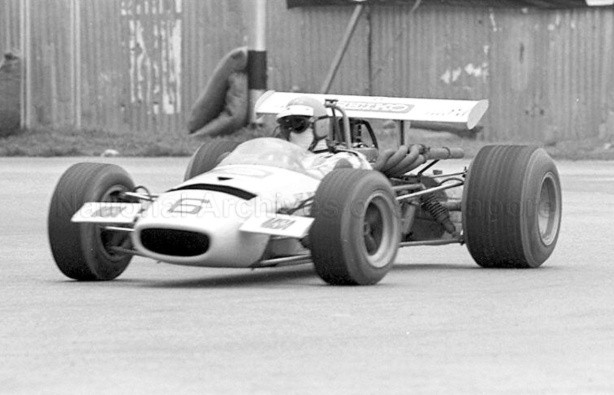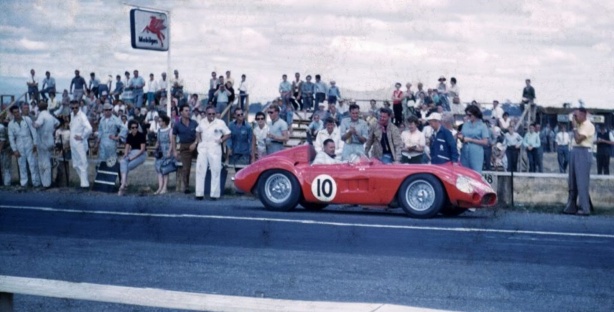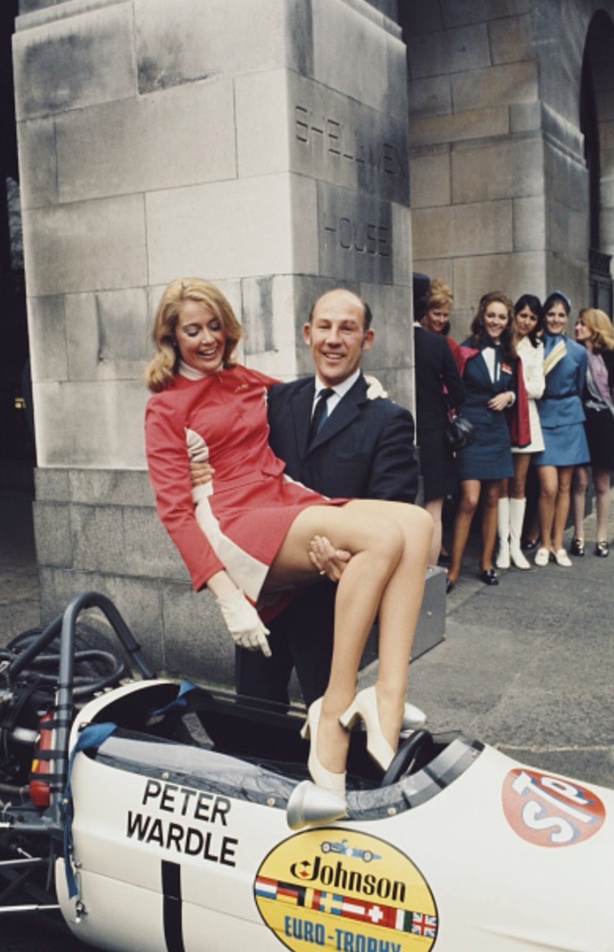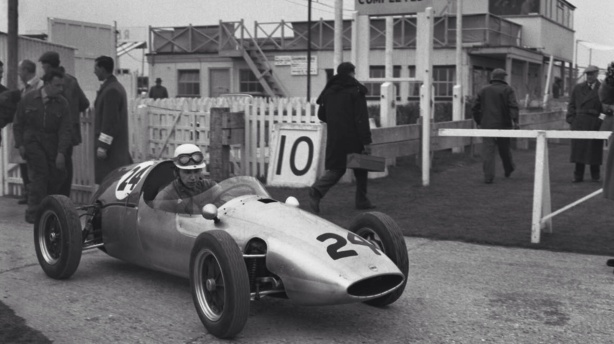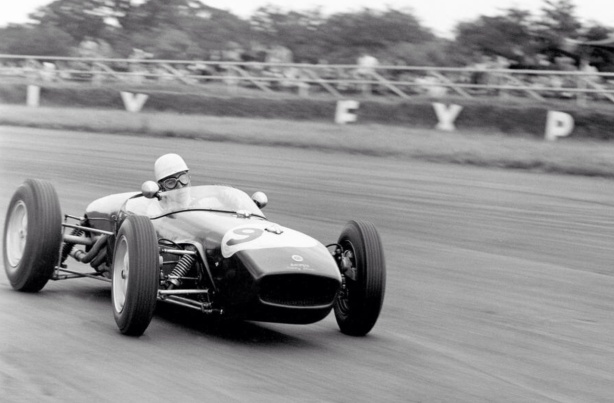Ron Flockhart and Mustang P51, Moorabbin Airport, Melbourne 1961…
I wrote an article three years ago about Ron Flockhart’s win together with Ivor Bueb aboard an Ecurie Ecosse Jag XKD at Le Mans in 1957 (he won in a D Type with Ninian Sanderson in ’56 too) and tangentially about his death in a Mustang P51 fighter in Melbourne’s Dandenong Ranges during preparations for his second attempt on the Australia-United Kingdon air record in April 1962. Click here to read it; https://primotipo.com/2015/01/17/le-mans-1957-d-type-jaguar-rout-ron-flockhart-racer-and-aviator/
Recently I came upon some photos of him in during the Summer of 1961 Australian internationals. This led to another Flockhart-Google-cruise and discovery of the substance of this piece, an article first published in Pilot magazine written by Neil Follett and Nick Stroud. That article is written from an aviation rather than a motor racing perspective. I found it fascinating, I know many of you crossover into ‘planes as well as cars so here ‘tis, the racing bits which are mine, will be clear I think.

Ron Flockhart in red and Ivor Bueb with Jag XKD606 after the 1957 Ecurie Ecosse Le Mans win (unattributed)
‘One of the first racing drivers to fly himself to meetings in his own aircraft, Ron Flockhart raced at the top level in sports cars and Formula One before a growing interest in long distance record flights led to high adventure and stark tragedy.
William Ronald Flockhart was born in Edinburgh on 16 June 1923. He began his motor racing career in 1951, going on to win the 24 Heures du Mans race in 1956 and 1957 while driving a D-Type Jaguar with the Scottish Ecurie Ecosse team. Flockhart also participated in Formula One races, entering his first−the British Grand Prix−in 1954 and continuing throughout 1956–60. The Scotsman competed in fourteen F1 races with five different teams, his best result being a third in the 1956 Italian Grand Prix at Monza.
Flockhart also displayed an early interest in flying, owning Auster 5 G-ANHO during 1954–57, and becoming one of the first Formula One drivers to fly their own aircraft to race meetings. In the early 1960s he became interested in record flights between England and Australia, noting that the record was held by Arthur Clouston and Victor Ricketts in the DH88 Comet G-ACSS Grosvenor House.
The Comet won the 1934 MacRobertson Air Race and was the aircraft in which Ricketts and Clouston flew from London to Sydney (and then on to New Zealand) in 80hr 56min in March 1938. Flockhart considered that this record could be bettered. He was also interested in bettering the standing solo Australia−UK record, held by H F ‘Jim’ Broadbent, who had left Darwin in Percival Vega Gull G-AFEH on 18 April 1938, and landed in England on the 22nd having covered 9,612 miles in five days 4hr 21min, the last pre-war record flight between the two countries.
In October 1960, British holding company United Dominions Trust (UDT), through its subsidiary Laystall Engineering, formed an agreement with the British Racing Partnership to form a motor-racing organisation known as UDT Laystall Racing. As an extension of its racing activities, UDT became involved in the purchase of (Commonwealth Aircraft Corporation, Fishermens Bend, Melbourne built) Commonwealth CA-17 Mustang Mk 20 VH-BVM for Flockhart’s record attempt.
This aircraft had originally been purchased from the RAAF by former RAF and RAAF pilot James L ‘Wac’ Whiteman, who intended to enter the aircraft in the 1953 London to Christchurch (New Zealand) Air Race. Wac withdrew from the race when he realised it would not be competitive with the jets entered and in 1954 its ownership passed to Arnold J Glass, a fellow racing driver against whom Flockhart would compete in the 1961 and 1962 New Zealand Grand Prix races. Used latterly for target-towing experiments, it was sold to UDT for around £2,000 with around 100 flying hours on the clock. Flockhart was also able to obtain 63 gallon combat droptanks for about £7 each’.
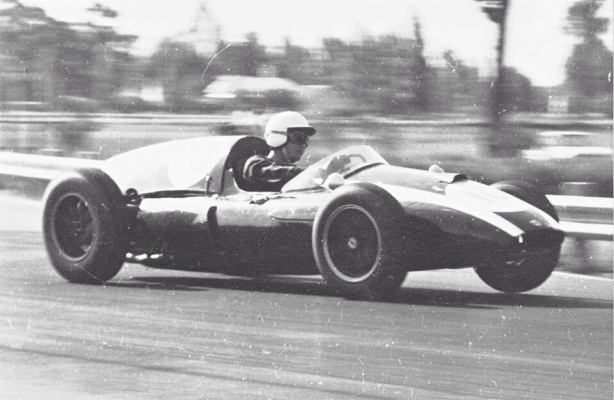
Flockhart with the unloaded left front of his Cooper T51 Climax just kissing the Warwick Farm Causeway tarmac in 1961 (J Arkwright)
Racing in New Zealand/Australia, Summer 1961…
Ron organised an ex-works Cooper for his limited campaign of races in the Antipodes in the hot summer of 1961. T51 Climax F2-7-59 was ‘ex-Works Car No 3 according to the Cooper Register…believed to be Masten Gregory’s regular car during 1959…Bruce McLaren’s race-winning car at both Sebring December 1959 and at Buenos Aires in February 1960…and may be either the works teams spare car during 1960…or the car sold to Fred Tuck for 1960’ according to oldracingcars.com. Whatever the case, while the T51 was a good jigger, it was no longer in the full flush of youth with the quicker cars that season the T53 ‘Lowline’ Coopers of Brabham and McLaren, the works P48 BRM’s of Graham Hill and Dan Gurney and Rob Walker’s Lotus 18 Climax driven by Stirling Moss.

Flockhart and Denny Hulme fighting for fourth place during the 1961 NZ GP at Ardmore both in Cooper T51 Climax 2.5 FPF, Ron fourth, Denny fifth (sergent.com)
Moss disappeared into the distance in the 7 January NZ GP at Ardmore but was outed with a badly slipping clutch mid-race giving the win to Brabham from McLaren, Hill and Flockhart in a plucky fourth.
With much preparation to do in Australia for his pending flight, he missed the balance of the NZ events and re-acquainted himself with the Cooper T51 at the first international meeting held at the new, technically challenging Warwick Farm circuit laid out amidst a horse-racing facility on the western suburban outskirts of Sydney on 29 January.

Getty Images caption dated 2 February 1961 notes ‘The Flying Scotsman’ is travelling from Australia to England on a dual mission – first to marry BOAC hostess Gillian Tatlow and second to attempt to break the Australia-Britain record for single-engine planes’ (Getty)
He was fifth in the Warwick Farm 100 held in scorching hot weather and won by the Moss Lotus 18 with its side-panels removed to help cope with the extreme conditions. A fortnight later he contested the last race of his ’61 tour, the Victoria Trophy that year held on a circuit laid out on Ballarat Airfield, Ballarat is in Victoria’s Goldfields region 120km from Melbourne.
Ron raced a Border Reivers Cooper T53 Climax to third to the works BRM P48s of Gurney and Hill with Dan scoring the only international win for that chassis that weekend. With that, and a fortnight until his scheduled Mustang departure for the UK he re-focused on a high-performance machine of an altogether different type.
Preparations begin…
‘With the end of the Antipodean motor racing season in early 1961, preparations began for the flight to the UK. Rolls-Royce ran checks on the Packard Merlin 38 engine, which had only run 110 hours since new, and which had never been ‘through the gate’. The magnetos were overhauled in Scotland and Smiths Australia set to work on overhauling the cockpit instruments.
Preparatory work on the airframe was undertaken at the Illawarra Flying School, which modified the fuel system by introducing a manual device by which the system could be de-pressurised. Two static vents were incorporated into the airframe under the cockpit sill, each containing a valve. This would enable Flockhart to run the drop-tanks dry without the risk of sucking air into the system. The system would then be re-pressurised from the exhaust side of the vacuum pump to assist initial transfer. This worked well, although a stiff bootful of rudder was required to counter the rolling moment caused by the change in lateral balance as a tank emptied.
In the limited space available in the Mustang’s cockpit two German Becker VHF radio sets were installed, which provided 36 communication channels, and Lear T12 automatic direction finding (ADF) equipment was fitted in the position usually occupied by the gunsight. No VOR, ILS, HF radio or marker-beacon receiver equipment was fitted−Flockhart held no instrument rating. Normalair supplied the oxygen equipment, Dunlop provided new tyres, and Lodge delivered new plugs. Rolls-Royce suggested that the Merlin be opened up to maximum continuous power every half-hour during the flight and again briefly during descent and approach.’

G-ARKD lookin’ a million bucks outside Fawcett’s hangar at Bankstown after final prep for the 1961 flight (G Goodall)
‘Final preparations and modifications were undertaken by Fawcett Aviation at Bankstown Aerodrome in Sydney, and the Mustang was officially added to the British register on 24 February 1961 as G-ARKD, in the name of Ronald Flockhart. In the days leading up to his departure for the UK Flockhart had logged a mere twelve flying hours in the Mustang.
In March 1961, Flockhart told British magazine Flight that piloting a Mustang for the first time was like ‘driving an ERA after a sports car; things happen very quickly’. He also admitted that it had taken some time to get used to the Mustang’s long nose and the technique of a curving approach, and had accordingly suffered ‘one or two bumpy landings’, but had quickly come to like the aeroplane very much. Flockhart noted that although the Mustang was big and powerful, ‘it was amply stable for the long hours of steady, level cruise’.
The planned route for the flight was Sydney—Alice Springs—Darwin—Sourabaya—Singapore —Rangoon—Calcutta—Karachi—Bahrain—Beirut—Brindisi—Nice and on to London, with overnight stops at Singapore, Karachi and Brindisi. Flockhart’s plan was to fly only during daylight hours and in segments of a maximum of five hours. All fuelling arrangments along the route were to be made by Esso, which Flockhart found to be ‘unfailingly helpful and efficient’
Setting off…
‘On Tuesday, February 28, 1961, Flockhart and G-ARKD, painted in an overall bright red colour scheme with white detailing, departed Sydney for the first stop at Alice Springs. Enroute from the latter to Darwin, Flockhart experienced a magnetically charged dust storm, which affected his ADF equipment. He settled in at 12,000ft and followed the faint line of a solitary railway across the endless red terrain to Darwin.
The next day Flockhart departed Darwin for Surabaya on Java. Well out over the Timor Sea he saw an ominous line in the distance, marking an inter-tropical front piling clouds up to 50,000ft and higher. From 12,000ft he dived to low altitude to find a hole in the milky mist. After ten minutes the Mustang popped through the other side of the front with most of the paint on its leading edges stripped off. The diversion had cost a substantial amount of fuel and Flockhart elected to divert to Baucau on East Timor for replenishment.’
‘After a quick refill from fuel kept in 45 gallon churns in a thatched hut, Flockhart took off for what he later recalled as ‘the loveliest part of the trip’ east-north-east over the Balinese islands and coral atolls to Singapore. The maximum endurance of the Mustang was seven hours, for six of which Flockhart could be on oxygen. Typical cruising speed was 225 knots at 12,000ft, although the speed would increase to 280 with the periodic opening of the throttle, as per Rolls-Royce’s suggestion.
The diversion to Baucau meant a late arrival at Singapore, where Flockhart was further delayed by an accident which had closed the runway at his next stop, Rangoon. Having received the all-clear to depart, Flockhart headed into the darkness, his first experience of flying the Mustang at night. Finding that the ADF equipment functioned better at night, he followed airways all the way to Rangoon, where the scarlet Mustang received a great deal of attention, not least from the Czechoslovakian crew of a SA Tupolev Tu-104.’
Across India…
‘The following morning there was still plenty of interest in the aircraft, and on departure for Calcutta Flockhart held the Mustang down on takeoff until he could pull up 4,000ft almost vertically into cloud.
Navigating largely by means of contact flying−using established landmarks−Flockhart experienced difficulties on the leg to Calcutta, becoming embroiled in a cloud layer at 2,000ft which caused him to miss the let-down beacon into Calcutta and overshoot, forcing him to put down at Barrackpore, some fifteen miles north of Calcutta.
After a swift refuelling, Flockhart was off again for the longest leg of the journey, across India and Pakistan to Karachi, which he completed in 5hr 50min using 43gal/hr of fuel. Flockhart later related that he ate only a few Horlicks tablets on this leg, and refreshed himself on landing at Karachi with ginger beer kept cold in the ammunition bays.
At Karachi the Mustang was turned around in less than an hour, Flockhart taking off in the moonlight to follow the Iranian coast to Bahrain. As he later told Flight: ‘Navigation at night was wonderful. There is a great tranquility about it. The isolation and the beauty contrasts sharply with the actions of those on the ground, who try to tie you down with streamers of paper. Flying at night in the moonlight, the only shadows are on the surface’.
It was still night when Flockhart landed at Bahrain, where he discovered that air had been leaking from the port main wheel oleo. This caused little concern however, and after a safe landing the undercarriage was quickly repaired by the RAF. Flockhart was soon off again, to follow an oil pipeline to the mountains of Lebanon and Beirut. He was cleared−and then recalled−by Damascus air traffic control shortly after passing over the city, but, short of fuel, he elected to continue to Beirut and face the consequences there.
It was indeed at Beirut where the trouble started.
Despite the diversions and delays owing to minor repairs, Flockhart was still well ahead of his own schedule when he taxied out at Beirut for the next leg to Brindisi on 3 March.
Confusion on the ground, however, led to the Mustang’s coolant boiling while Flockhart was held while other aircraft landed. The Mustang finally departed for Brindisi but poor weather forced Flockhart to divert to his nominated alternate, Athens.’

G-AKRD on the deck at Athens Airport. Aircraft later damaged by a cockpit fire, left exposed for years in Athens and eventually scrapped, now seemingly resurrected from the dead (I Leslie)
‘Anxious not to lose any more time, Flockhart refuelled quickly and requested clearance from the Tower, which was refused as no flight plan had been filed. Requesting to file an airborne flight plan, Flockhart was refused again, the Tower demanding that he pay landing fees, despite the fact that these had already been seen to by Esso. As Flight elegantly put it: ‘temperatures rose−in the Tower, in the cockpit and in the cylinder heads’.
Realising that resistance was futile, Flockhart retired for a rest, before trying again in a few hours. With the paperwork sorted, he returned to the Mustang in the early morning, but found on starting that steam was issuing from the cowling. Refilling the coolant system, he found that the coolant was running out between Nos 3 and 4 cylinders on the starboard bank. By this time he was twelve hours behind his schedule, but two days ahead of the solo record.
Exhausted and frustrated, Flockhart left G-ARKD at Athens and continued to London by commercial airliner to be married as planned a few days later on 11 March 1961. The Scotsman subsequently told Flight that it was ‘not the flying, nor navigation, nor preparation which was responsible for the failure. It was an air traffic system out of touch with the individual needs of a type of flying that has not yet, by any means, disappeared from the global scene’.
In September 1961 the Mustang was severely damaged by a cockpit fire while being taxied at Athens airport, putting paid to its use in any further record attempt.’

Arnold Glass’ BRM P48 inside Ron Flockhart’s Lotus 18 Climax, DNF for both – Lycoming Special of Forrest Cardon to the right 16th- Maser 250F to the left of Cardon is Chris Amon in 11th to the Lycoming’s left, Ardmore 1962 (sergent.com)
Racing in Australasia 1962…
There was plenty of the depth in the international fields local drivers confronted in 1962. Vsitors included Moss back with a choice of Rob Walker cars – Lotus 21 and Cooper T53, McLaren and John Surtees also ran T53s with Jack in a T55. We had our first look at Jim Clark aboard a Team Lotus Lotus 21 Climax but like Flockhart, Clark was hamstrung a bit by having only a 2.5 FPF, in the hands of the top-liners de-rigeur in ’62 was a 2.7 FPF Indy engine. Ron raced a Border Reivers Lotus 18.
In a bit of Mini Cooper racing trivia, the first such cars were taken to New Zealand and on to Australia by Bruce McLaren and Ron, a third car intended for Roy Salvadori missed the trip. They raced the ‘bricks’ at several of the meetings in which they contested the feature races with their GP cars. The potential of the machines, despite their size, wasn’t lost of any of the racers or spectators who watched cars which of course became icons which define an age.

Dennis Marwood’s Humber leads Jim Steans Mini and the Coopers of McLaren and Flockhart at Wigram in 1962 (J Steans)
It was a mediocre tour really, Ron’s two NZ races were the NZ GP at Ardmore and Lady Wigram Trophy with DNF’s due to engine problems and a failed universal joint respectively. Moss won both races, the NZ GP was famously a very soggy one, in the Lotus 18 2.5 FPF.
Fifth at Warwick Farm was much better for Ron and a high point, Moss took that win too, this time aboard the T53 2.7 having tried both cars in practice. Moss preferred the more-chuckable Cooper to the Lotus around the ‘Farm. Flockhart had an early day in the Lakeside International after a collision on lap 20, the race was won by Brabham’s T55.
Flockhart missed the Longford round won by Surtees and rejoined for the first Sandown International, like Warwick Farm it was laid out within a horse-racing facility and on Melbourne’s then south-eastern outskirts 40km from the city. Brabham won again with Flockhart suffering bearing failure in what turned out to be his very last motor-race.
Sandown Park is only 10km from Moorabbin Airport and 30km from Kallista in the Dandenongs, both sadly to loom large for all the wrong reasons shortly thereafter.
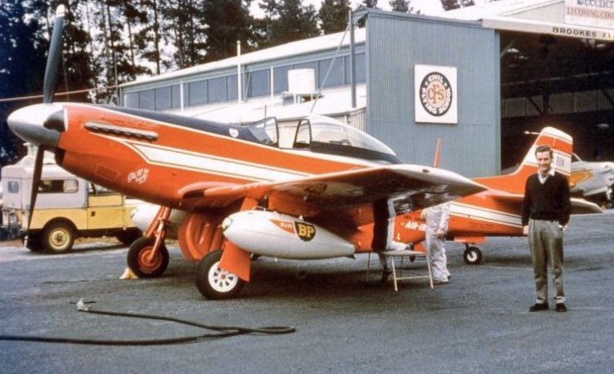
Flockhart and mount, outside the Brookes Aviation hangar, Moorabbin Airport, fateful morning of 12 April 1962 (G Goodall)
Take two…
Not to be deterred, within months of the 1961 Athens airport fire Flockhart began looking for another Australian Mustang for a second attempt on the record that had eluded him. The aircraft chosen was former RAAF Mustang VH-UWB, acquired on Ron’s behalf by AREF Ltd of Ascot, Berkshire and registered G-ARUK. Flockhart had announced his intention to try and beat the record again, with plans to follow the route Melbourne—Sydney—Darwin—Singapore—Madras—Bahrain—Brindisi—London, starting on 16 April 1962.
‘Jock Garden, chief flying instructor and manager of the Civil Flying School, the flying training arm of the Mustang’s operator in Australia, Brookes Aviation, recalled in his memoirs: ‘Ron arranged to buy VH-UWB from John Brookes, and Brookes Aviation undertook a complete overhaul on the aircraft. Rolls-Royce, as a co-sponsor [of his next record attempt], sent out two engineers from England to service the engine; the aircraft was repainted in red and re-registered in the UK as G-ARUK.
I flew Ron over to Essendon Airport in the [Beech] Debonair early in 1962 and during the flight I asked if he had any recent instrument flying experience. When he told me he had none in the last eighteen months, I suggested it would be wise for him to gain recent instrument flying practice in view of the intended long flight, but he did not follow up on that advice.
‘I had the pleasure of doing the flight-testing of the Mustang on 19 March 1962, after its extensive servicing and it was in perfect condition with the Merlin the smoothest running engine I had ever encountered.’
‘A couple of days before he intended setting out on his record attempt Ron was to fly to Sydney to have maintenance done on his ADF unit. The weather conditions on 12 April were bad, with low cloud and rain, but Ron was determined to go. This proved to be a fatal decision as, within only a few minutes after departure, he lost control in cloud over the Dandenong Range and entered a spiral dive from which he could not possibly recover. He was killed instantly.’
The official report of the accident by the Australian Department of Civil Aviation gives the following conclusion: ‘While there is insufficient evidence to establish conclusively the cause of the accident, the possibility that the pilot temporarily lost control of the aircraft while circling in cloud, and that it subsequently stalled during the recovery and turn to avoid high terrain, cannot be excluded’.
Flockhart was flying the Mustang from Moorabbin to Bankstown to conduct fuel consumption tests and have the ADF equipment serviced. After encountering low cloud, he reported that he was returning to Moorabbin. The Mustang then changed course some 140° before entering a narrow gap between cloud-obscured hilltops in the Dandenongs.
The report stated that ‘the pilot circled in the vicinity of Kallista several times at low altitude and for the most part in cloud. The aircraft then emerged below cloud at a height of approximately 1,300ft, carried out a left turn probably to avoid higher terrain and, in the course of this turn, the nose dropped sharply and the aircraft struck trees and the ground at a steep angle, while rolling and turning to the right’.
At the time of the accident Flockhart held a British PPL endorsed for single-engined landplanes under 12,500lb (5,670kg) maximum permissible all-up weight. His total flying time was 961hr of which 69 were on Mustangs. During the six months immediately before the accident he had flown only five hours. He was not rated for instrument or night flying. In late 1960 he had undergone about 21 hours of ground-based Link trainer instruction on ADF, ILS and VDF procedures, but his logbook showed no record of any instrument flying or Link trainer instruction since that time.
Flockhart’s flying achievements were substantial and deserve a great deal of credit; his Mustang flight from Australia to Athens had been made with limited professional backing by a club-trained private pilot. Sadly, he never got the chance to finish the job — with his death on 12 April 1962, his final race had been run.’
Etcetera…

Flockhart hooting across the braking area for Warwick Farm’s Causeway during the WF 100 in 1961, Cooper T51 Climax ( J Arkwright)

Flockhart’s Cooper T51 Climax in the Warwick Farm paddock in 1961. Car raced to a Longford win by Roy Salvadori the week later and then sale to David McKay at the end of the summer post the Hume Weir meeting also contested by Roy (J Arkwright)

Mustang A68-152, 135 and 175. All aircraft issued to 23 Squadron Brisbane so guessing RAAF Amberley circa late 1952/3. CAC Wirraway’s alongside (L Potts)
Etcetera: The Commonwealth Aircraft Corporation Mustang P51’s…
Source: airforce.gov.au- Point Cook Museum, Victoria
‘One of the finest American fighter aircraft of World War II, the North American Mustang owed its origin to a Royal Air Force (RAF) specification for a single-seat fighter to replace the Curtiss P-40. The first flight of the prototype NA-73 occurred in October 1940. Production models reached the RAF in November 1941 and these aircraft became known as Mustang Mk I (P-51) and Mk II (P-51A). The original 1,150hp Allison engine lacked performance at high altitude, and the RAF employed the early Mustangs on low-level armed tactical reconnaissance sorties. Meantime, the US Army Air Force (USAAF) ordered a limited number of P-51s and P-51As as the Apache, to operate in the dive-bomber role.
However, once the basic P-51 design was mated with the proven Rolls-Royce Merlin engine, the aircraft became an enormous success. Through P-51B, C and D models, the Mustang became one of the finest Allied fighters of World War II, and was just as capable at long-range escort as short ground-attack sorties. Fitted with a bubble canopy in place of the earlier ‘Razorback’ fuselage, the P-51D was the most widely produced version of the Mustang, with 8,956 built.
Interesting developments of the Mustang included the XP-51F and XP-51G lightweight versions and, the fastest Mustang of all, the P-51H, with a top speed of 487 mph at 25,000 ft. The ultimate development of the aircraft occurred post-war, when two Mustang fuselages were joined, resulting in the USAAF’s F-82 Twin Mustang.
In November 1944, RAF Mustangs were first flown by the RAAF’s No 3 Sqn in Italy.
In 1943, the Australian government arranged for the Commonwealth Aircraft Corporation (CAC) to manufacture the Mustang Mk IV (P-51D) under licence from North American Aviation. The RAAF urgently needed a new fighter, and so the first CAC Mustangs were built mainly from imported semi-finished parts. A prototype Mustang, A68-1001, was used for development trials and the first Australian production Mustang, A68-1, flew on 29 April 1945. This aircraft was handed over to the RAAF on 4 June 1945 and was used for trials by No 1 Aircraft Performance Unit until October 1946. It was placed in storage until 1953 when it was delivered to the Department of Supply at Woomera.
The first 80 Mustang 20s (A68-1/80) were delivered with Packard Merlin V-1650-3 engines, under the CA-17 designation. A second contract called for 170 improved Mustangs, but only 120 were completed. Known as CA-18, the first 40 were built as Mustang 21s (A68-81/120) with Packard Merlin V-1650-7 engines. The remaining CA-18s comprised 14 Mustang 22s (A68-187/200) with Packard Merlin V-1650-7 engines. A CA-21 contract for a further 250 Mustangs was cancelled and, in lieu of the remaining CA-18s and CA-21s, 298 lend-lease P-51Ds and Ks were taken on strength (A68-500/583 and A68-600/813). In addition, the RAAF also accepted Mustangs for the Netherlands East Indies Air Force (N3-600/640).
Produced too late for World War II, RAAF Mustangs were assigned to Japan for occupation duties and, early in 1946, Nos 76, 77 and 82 Squadrons flew into Iwakuni. In 1949 Nos 76 and 82 Squadrons withdrew to Australian and the Mustangs of No 77 Squadron remained to take part in the Korean War from June 1950 until April 1951, when they were replaced by Gloster Meteors.
In Australia, Mustangs remained in service with Citizen’s Air Force Squadrons until they were withdrawn from service in 1959.’
Technical Specifications CAC CA-18 Mustang Mk21…
Type/Airframe- Single seat long range fighter. All metal stressed skin construction
Engine- Single Packard Merlin V1650-7. SOHC, 2 valve, carburettor fed, two-stage supercharged V12. Bore/stroke 5.4×6 inches, 1650 cid, circa 1490 bhp @ 3000 rpm. Weight 1640 pounds
Dimensions- Span 11.28 m (37 ft): length 9,83 m (32 ft 3 in); height 3.71 m (12 ft 2 in).
Weight- Empty 3567 kg (7863 lb); loaded 4763 kg (10 500 lb).
Performance- Max speed 636 km/h (380 kt); Climb, 13 mins to 30,000 ft (9144 m); Maximum rate of climb 1059 m (3475 ft)/min; Service ceiling 41,900 ft (12 771 m); Range 1529 km (825 nm) on internal fuel tanks.
Armaments- Six 0.50 in calibre machine guns; two 454 kg (1000 lb) bombs or up to 10 rockets

CA-17 A68-34 a pretty picture. Issued to 25 Squadron in 1951/2 so probably in the air over RAAF Pearce, Perth (SLSA)
Plane dudes have as much interest in chassis numbers et al as us car chaps of course, here they are..
A68-5 RAAF Serial no / Type CA-17 Mk20 Mustang / Construction no 1330 NA110-34370 (Flockhart’s 1961 plane)
Early build- 5th of a batch of 80 shipped to Oz as kits of parts, delivered to 1 Aircraft Depot ex-CAC 6 July 1945. To 78 Sqdn, then stored 14/11/45 till sold 30/1/53 to ex-Flt Lt JL Whiteman with only 35 hours up, Sydney- reg VH-BVM. To Arnold Glass, purportedly acquired with winnings from a racehorse ‘Johnny Zero’ which the aircraft was then called, Sydney May 1954. Target towing experiments with Fawcett Aviation in 1959, also flown by A Oates. To Ron Flockhart August 1960 with around 100 hours on the clock- reg UK G-ARKD Feb 1961. ‘Abandoned’ in Greece 4/3/61, cockpit fire whilst being taxied in Athens 7/9/61. Rego cancelled by UK CAA as ‘aircraft destroyed’ 26/11/61. Abandoned and left in the open in Athens 1961-1970. Reportedly broken up for scrap in Athens circa 1970.
6 June 2012 re-registered as G-ARKD to ‘Classic Flying Machine Collection Ltd’, Foulsham, Dereham, Norfolk, UK-‘remains/parts storage for restoration’
A68-113 RAAF Serial no / Type CA-18 Mk21 Mustang / Construction no 1438 (Flockhart’s 1962 plane)
Delivered to 1 Aircraft Depot ex-CAC on 1 April 1948. Issued to 78 Wing November 1949, to 1 AD July 1950, 10 Sqdn Townsville May 1953 for target towing duties. Sold August 1957, then again February 1958- Reg VH-UWB. Sold to Flockhart April 1962- reg UK G-ARUK. Flockhart’s fatal crash at Kallista 12 April 1962. Rego cancelled by UK CAA as ‘aircraft destroyed’ on 23/5/62.
Photo Credits…
Pilot magazine, Geoff Goodall Collection, W Cdr L Brighton, Ian Leslie, Jim Steans Collection, John Arkwright, autopics.com.au, Lionel Potts, Museum of Victoria, State Library of South Australia, Tony Lyons, Haynes, Aeroplane magazine
Bibliography…
Pilot magazine article by Neil Follett and Nick Stroud via aeroexpo.co.uk, sergent.com, oldracingcars.com, adf-serials.com.au, airforce.gov.au
Tailpiece: Cool dude- Flockhart, Warwick Farm 1961…
Finito…
